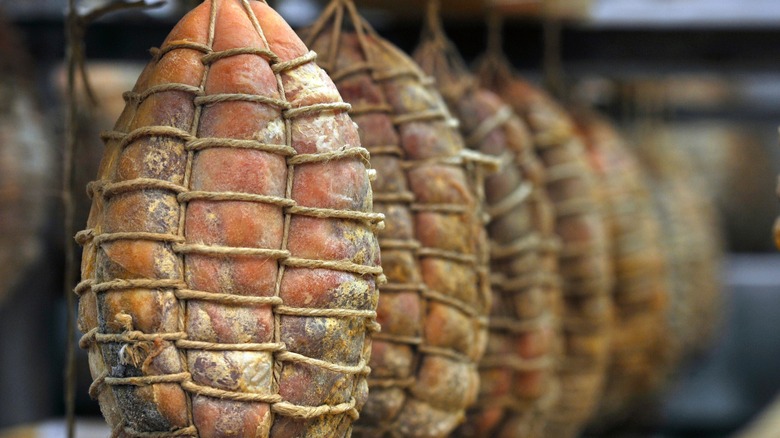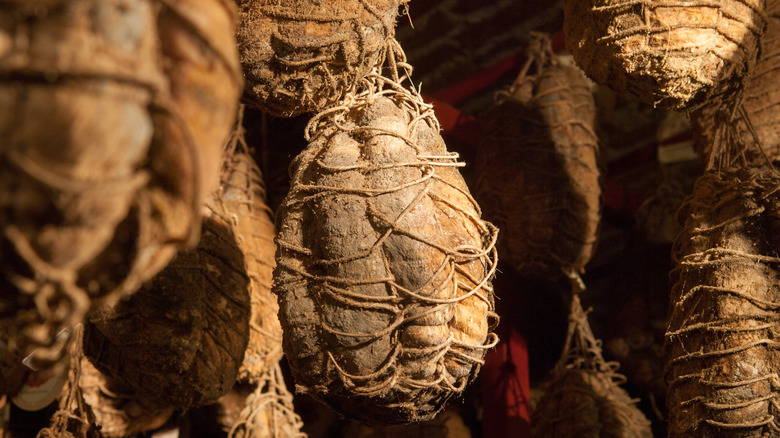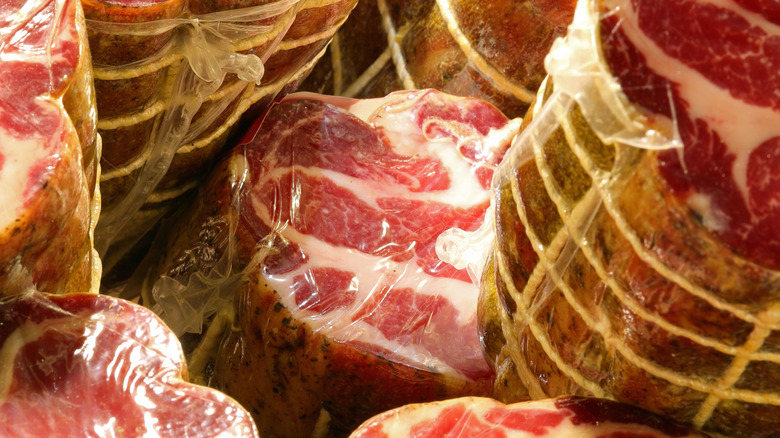The Medieval Italian Ham The US Has Been Missing Out On
Over in Europe, cured meat is big business. According to SIAL Paris, the European market represents a €62 billion turnover, with production reaching over 14 million tonnes. The stand-out nations for cured meat are Spain and Italy. The Spanish produce the absolutely brilliant jamón ibérico, while the Italians are busy curing up massive quantities of prosciutto di parma. To be clear, it's not as though just anyone can produce these finely crafted hams. You need to follow a strict set of rules, live in the right place, and be a properly certified producer in order to call your product authentic.
There are two authenticating classifications: IGP (Indication of Geographic Protection) and DOP (Protected Designation of Origin). These certifications ensure that the hams you are buying are the real deal by setting strict requirements of how and exactly where certain foods can be produced (via Eataly). One of the best examples of this is the Parmigiano Reggiano, which can only be produced in Emilia Romagna in north-central Italy. However, there is another ham of equal protection and quality that has been produced since medieval times. It is one that we here in the states have been missing out on eating for decades. It's called culatello, and if you come across some, you should most certainly try it.
The origins of culatello
Culatello has been made in the same area of Italy since medieval times. Italy is broken up into regions, within which there are provinces. Culatello comes from the lowlands of the Parma province in the north of the Emilia-Romagna region. If the name Parma sounds familiar, it is because the province is also known for prosciutto di parma and Parmigiano Reggiano. The culatello, however, is something of a hidden local gem, having been developed by the farmers of the Zibello area of Parma as far back as 1300 (via Parma-Italy.com and Food and Wine).
According to Saveur, only eight local villages within the Zibello area can produce culatello, which is part of the reason it is so rare to find any outside of the Italian market. One of the oldest continuing culatello cellars can be found at the Michelin-starred restaurant Antica Corte Pallavicina. Their cellars, which were once part of the estate of a marquis, have been curing culatello since 1320, building up 700 years' worth of the mold that helps give the culatello its unique, sought-after flavor.
Culatello is made differently than any other cured meat
According to Food and Wine, the way in which culatello is made has not changed a wink since the middle ages. The process begins with the cut of pig. The choicest section of the thigh muscle is selected for the curing process. This cut gives the culatello its name, as it literally translates to "little ass." The meat is then seasoned with liberal amounts of salt, black pepper, and garlic before being wrapped in a clean pig's bladder. It is then netted and hung for curing in a cold, wet cellar.
There is no special trick to the aging process of culatello. Unlike its cousin, the prosciutto, which needs strict temperature control to age properly, temperature control for culatello is as simple as opening or closing a window, per Saveur. The key ingredient, however, is one Food and Wine describes as hyper-local. The fog of the nearby Po River, which constantly covers the fields of the Zibello area, is an essential component of curing culatello. The fog helps maintain that cold wetness in the curing cellars, which creates the perfect environment for the mold that cases the cured meat during the requisite 12 months of aging. This outer crust of mold gives culatello a unique, bold flavor.
Taste and how to eat culatello
The flavor of culatello is not something that can be pinned down or described without invoking words like musk or smokey or downright ephemeral, as Saveur does. Locals in the Zibello area say it has the taste of fog. However, unless you're planning on visiting one of the eight villages that produce this quality ham, you won't have any idea what Po River fog tastes like. It's anomalies like these that make culatello different from any other cured meat. Outwardly, it looks similar in color to a Spanish jamón, but once sliced, culatello has the texture of a thin lardo and reportedly dissolves in your mouth as such.
Culatello is served primarily as an appetizer, much like a salami or prosciutto. According to La Cucina Italiana, culatello is served thinly sliced with toast. The preferred bread is the special gnocco fritto, which is specific to Emilia-Romagna. This bread is a simple concoction of water, flour, salt, and baking soda that's been shaped into squares and fried in lard. Culatello should be served at room temperature to attain that melt-in-your-mouth texture but can be stored in the refrigerator for two to three days if wrapped properly.
Why we've been missing out
As with most of the cool and tasty things the Europeans have enjoyed for hundreds of years, the reason Americans haven't been able to partake in enjoying them is government bans. According to the Los Angeles Times, the federal government had placed a restriction on any pork products that could possibly contain a disease called swine vesicular disease. This disease is killed either by cooking or long curing. Remember, culatello only has a short, 12-month aging process. So, unlike mortadella and prosciutto, culatello could not be imported into the United States over concerns about this disease, which was first seen in Italy during the 1960s.
However, in 2013, when the cited Los Angeles Times article was published, the USDA decided that the northern regions of Italy were clear of the swine disease, and imports of previously restricted meats could begin. Though the determination was in 2013, the USDA did not clear culatello for import until 2017, per Food and Wine. Now, this Italian delicacy can be found in shops like Eataly and Italian specialty stores — a win for Americans and for food.




